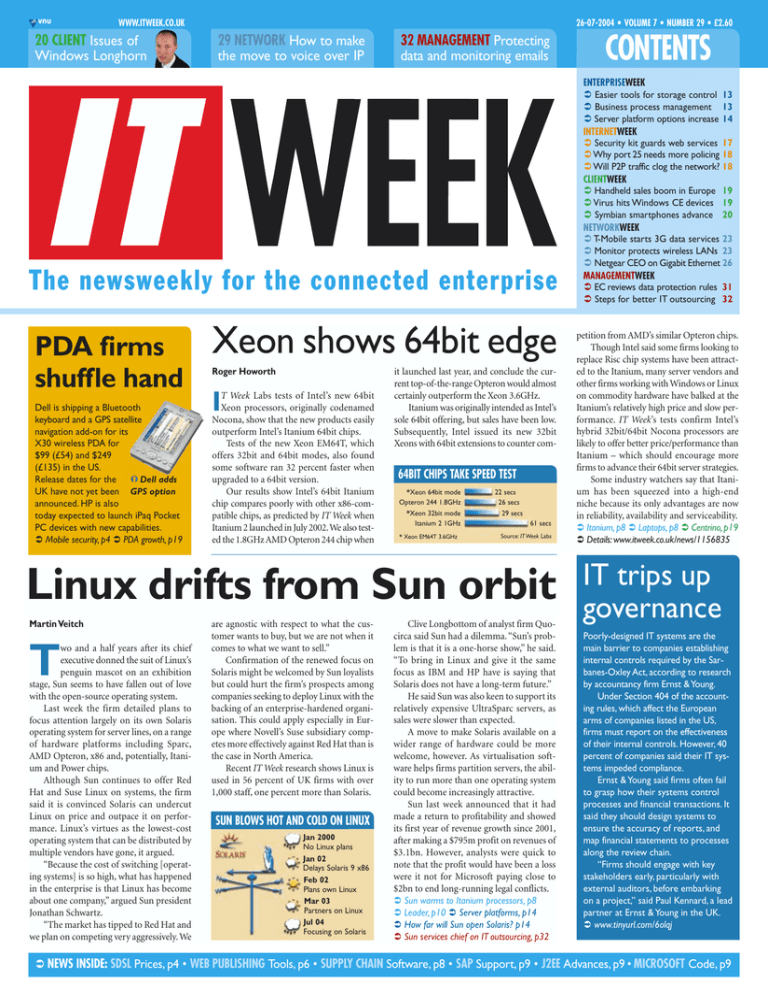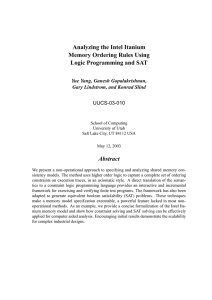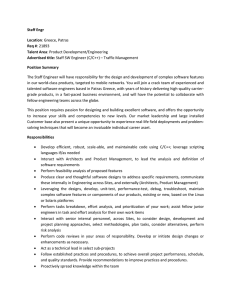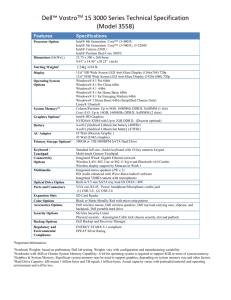CONTENTS
advertisement

26-07-2004 • VOLUME 7 • NUMBER 29 • £2.60 WWW.ITWEEK.CO.UK 20 CLIENT Issues of Windows Longhorn 29 NETWORK How to make the move to voice over IP 32 MANAGEMENT Protecting data and monitoring emails CONTENTS ENTERPRISEWEEK Easier tools for storage control 13 Business process management 13 Server platform options increase 14 INTERNETWEEK Security kit guards web services 17 Why port 25 needs more policing 18 Will P2P traffic clog the network? 18 CLIENTWEEK Handheld sales boom in Europe 19 Virus hits Windows CE devices 19 Symbian smartphones advance 20 NETWORKWEEK T-Mobile starts 3G data services 23 Monitor protects wireless LANs 23 Netgear CEO on Gigabit Ethernet 26 MANAGEMENTWEEK EC reviews data protection rules 31 Steps for better IT outsourcing 32 PDA firms shuffle hand Dell is shipping a Bluetooth keyboard and a GPS satellite navigation add-on for its X30 wireless PDA for $99 (£54) and $249 (£135) in the US. Release dates for the Dell adds UK have not yet been GPS option announced. HP is also today expected to launch iPaq Pocket PC devices with new capabilities. Mobile security, p4 PDA growth, p19 Xeon shows 64bit edge Roger Howorth I T Week Labs tests of Intel’s new 64bit Xeon processors, originally codenamed Nocona, show that the new products easily outperform Intel’s Itanium 64bit chips. Tests of the new Xeon EM64T, which offers 32bit and 64bit modes, also found some software ran 32 percent faster when upgraded to a 64bit version. Our results show Intel’s 64bit Itanium chip compares poorly with other x86-compatible chips, as predicted by IT Week when Itanium 2 launched in July 2002. We also tested the 1.8GHz AMD Opteron 244 chip when it launched last year, and conclude the current top-of-the-range Opteron would almost certainly outperform the Xeon 3.6GHz. Itanium was originally intended as Intel’s sole 64bit offering, but sales have been low. Subsequently, Intel issued its new 32bit Xeons with 64bit extensions to counter com- 64BIT CHIPS TAKE SPEED TEST *Xeon 64bit mode Opteron 244 1.8GHz *Xeon 32bit mode Itanium 2 1GHz * Xeon EM64T 3.6GHz 22 secs 26 secs 29 secs 61 secs Source: IT Week Labs Linux drifts from Sun orbit Martin Veitch wo and a half years after its chief executive donned the suit of Linux’s penguin mascot on an exhibition stage, Sun seems to have fallen out of love with the open-source operating system. Last week the firm detailed plans to focus attention largely on its own Solaris operating system for server lines, on a range of hardware platforms including Sparc, AMD Opteron, x86 and, potentially, Itanium and Power chips. Although Sun continues to offer Red Hat and Suse Linux on systems, the firm said it is convinced Solaris can undercut Linux on price and outpace it on performance. Linux’s virtues as the lowest-cost operating system that can be distributed by multiple vendors have gone, it argued. “Because the cost of switching [operating systems] is so high, what has happened in the enterprise is that Linux has become about one company,” argued Sun president Jonathan Schwartz. “The market has tipped to Red Hat and we plan on competing very aggressively. We T are agnostic with respect to what the customer wants to buy, but we are not when it comes to what we want to sell.” Confirmation of the renewed focus on Solaris might be welcomed by Sun loyalists but could hurt the firm’s prospects among companies seeking to deploy Linux with the backing of an enterprise-hardened organisation. This could apply especially in Europe where Novell’s Suse subsidiary competes more effectively against Red Hat than is the case in North America. Recent IT Week research shows Linux is used in 56 percent of UK firms with over 1,000 staff, one percent more than Solaris. SUN BLOWS HOT AND COLD ON LINUX Jan 2000 No Linux plans Jan 02 Delays Solaris 9 x86 Feb 02 Plans own Linux Mar 03 Partners on Linux Jul 04 Focusing on Solaris Clive Longbottom of analyst firm Quocirca said Sun had a dilemma. “Sun’s problem is that it is a one-horse show,” he said. “To bring in Linux and give it the same focus as IBM and HP have is saying that Solaris does not have a long-term future.” He said Sun was also keen to support its relatively expensive UltraSparc servers, as sales were slower than expected. A move to make Solaris available on a wider range of hardware could be more welcome, however. As virtualisation software helps firms partition servers, the ability to run more than one operating system could become increasingly attractive. Sun last week announced that it had made a return to profitability and showed its first year of revenue growth since 2001, after making a $795m profit on revenues of $3.1bn. However, analysts were quick to note that the profit would have been a loss were it not for Microsoft paying close to $2bn to end long-running legal conflicts. Sun warms to Itanium processors, p8 Leader, p10 Server platforms, p14 How far will Sun open Solaris? p14 Sun services chief on IT outsourcing, p32 petition from AMD’s similar Opteron chips. Though Intel said some firms looking to replace Risc chip systems have been attracted to the Itanium, many server vendors and other firms working with Windows or Linux on commodity hardware have balked at the Itanium’s relatively high price and slow performance. IT Week’s tests confirm Intel’s hybrid 32bit/64bit Nocona processors are likely to offer better price/performance than Itanium – which should encourage more firms to advance their 64bit server strategies. Some industry watchers say that Itanium has been squeezed into a high-end niche because its only advantages are now in reliability, availability and serviceability. Itanium, p8 Laptops, p8 Centrino, p19 Details: www.itweek.co.uk/news/1156835 IT trips up governance Poorly-designed IT systems are the main barrier to companies establishing internal controls required by the Sarbanes-Oxley Act, according to research by accountancy firm Ernst & Young. Under Section 404 of the accounting rules, which affect the European arms of companies listed in the US, firms must report on the effectiveness of their internal controls. However, 40 percent of companies said their IT systems impeded compliance. Ernst & Young said firms often fail to grasp how their systems control processes and financial transactions. It said they should design systems to ensure the accuracy of reports, and map financial statements to processes along the review chain. “Firms should engage with key stakeholders early, particularly with external auditors, before embarking on a project,” said Paul Kennard, a lead partner at Ernst & Young in the UK. www.tinyurl.com/6olqj NEWS INSIDE: SDSL Prices, p4 • WEB PUBLISHING Tools, p6 • SUPPLY CHAIN Software, p8 • SAP Support, p9 • J2EE Advances, p9 • MICROSOFT Code, p9





